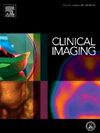Diversity, inclusivity and traceability of mammography datasets used in development of Artificial Intelligence technologies: a systematic review
IF 1.8
4区 医学
Q3 RADIOLOGY, NUCLEAR MEDICINE & MEDICAL IMAGING
引用次数: 0
Abstract
Purpose
There are many radiological datasets for breast cancer, some which have supported the development of AI medical devices for breast cancer screening and image classification. This review aims to identify mammography datasets (including digitised screen film mammography, 2D digital mammography and digital breast tomosynthesis) used in the development of AI technologies and present their characteristics, including their transparency of documentation, content, populations included and accessibility.
Materials and methods
MEDLINE and Google Dataset searches identified studies describing AI technology development and referencing breast imaging datasets up to June 2024. The characteristics of each dataset are summarised. In particular, the accompanying documentation was reviewed with a focus on diversity and inclusion of populations represented within each dataset.
Results
254 datasets were referenced in the literature search, 190 were privately held, 36 had barriers which prevented access, and 28 were accessible. Most datasets originated from Europe, East Asia and North America. There was poor reporting of individuals' attributes: 32 (12 %) datasets reported race or ethnicity; 76 (30 %) reported female/male categories with only one dataset explicitly defining whether these categories represented sex or gender attributes.
Conclusion
Through this review, we demonstrate gaps in the data landscape for mammography, highlighting poor representation globally. To ensure datasets in breast imaging have maximum utility for researchers, their characteristics should be documented and limitations of datasets, such as their representativeness of populations and settings, should inform scientific efforts to translate data-driven insights into technologies and discoveries.
人工智能技术开发中乳房x光检查数据集的多样性、包容性和可追溯性:系统综述
目的乳腺癌放射学数据集很多,其中一些数据集支持了用于乳腺癌筛查和图像分类的人工智能医疗设备的开发。本综述旨在确定用于人工智能技术开发的乳房x光检查数据集(包括数字化屏幕胶片乳房x光检查、2D数字乳房x光检查和数字乳房断层合成),并介绍其特征,包括文档的透明度、内容、包括的人群和可及性。材料和方法medline和谷歌数据集搜索确定了描述人工智能技术发展的研究,并参考了截至2024年6月的乳房成像数据集。总结了每个数据集的特征。特别地,对随附的文件进行了审查,重点关注每个数据集中所代表的人口的多样性和包容性。结果共检索到254个数据集,其中私有数据集190个,存在访问障碍数据集36个,可访问数据集28个。大多数数据集来自欧洲、东亚和北美。对个人属性的报告很差:32个(12%)数据集报告了种族或民族;76个(30%)报告了女性/男性类别,只有一个数据集明确定义了这些类别是否代表性别或性别属性。通过这篇综述,我们展示了乳房x光检查数据格局的差距,突出了全球代表性不足。为了确保乳腺成像中的数据集对研究人员有最大的效用,它们的特征应该被记录下来,数据集的局限性,比如它们对人群和环境的代表性,应该为科学工作提供信息,将数据驱动的见解转化为技术和发现。
本文章由计算机程序翻译,如有差异,请以英文原文为准。
求助全文
约1分钟内获得全文
求助全文
来源期刊

Clinical Imaging
医学-核医学
CiteScore
4.60
自引率
0.00%
发文量
265
审稿时长
35 days
期刊介绍:
The mission of Clinical Imaging is to publish, in a timely manner, the very best radiology research from the United States and around the world with special attention to the impact of medical imaging on patient care. The journal''s publications cover all imaging modalities, radiology issues related to patients, policy and practice improvements, and clinically-oriented imaging physics and informatics. The journal is a valuable resource for practicing radiologists, radiologists-in-training and other clinicians with an interest in imaging. Papers are carefully peer-reviewed and selected by our experienced subject editors who are leading experts spanning the range of imaging sub-specialties, which include:
-Body Imaging-
Breast Imaging-
Cardiothoracic Imaging-
Imaging Physics and Informatics-
Molecular Imaging and Nuclear Medicine-
Musculoskeletal and Emergency Imaging-
Neuroradiology-
Practice, Policy & Education-
Pediatric Imaging-
Vascular and Interventional Radiology
 求助内容:
求助内容: 应助结果提醒方式:
应助结果提醒方式:


